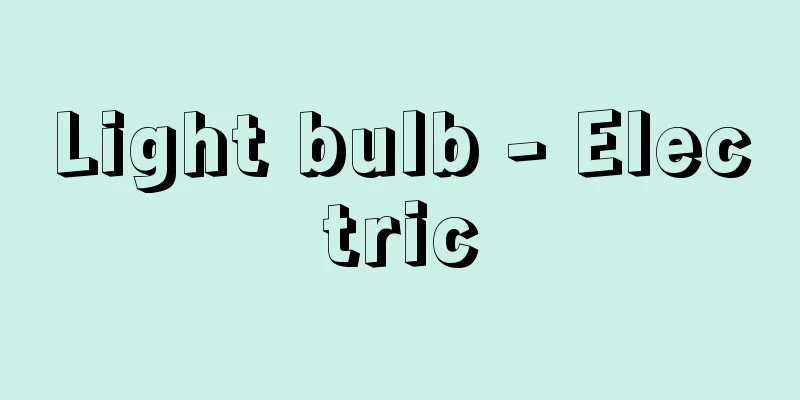Light bulb - Electric

|
A lamp that uses inert gases such as argon or nitrogen sealed inside a glass bulb, passes an electric current through a filament made of thin tungsten wire, and uses light emitted from a high temperature of over 2000°C. It is also called an incandescent light bulb because it uses the incandescent heat of the filament, and also called a tungsten light bulb because it uses tungsten wire for the filament. It has also been called an electric light bulb since ancient times, as it has been a representative form of electric lighting. [Akio Obara and Makoto Bessho] history(1) Carbon light bulb The first light bulb was put to practical use by Edison in 1879 as the carbon light bulb. Around the same time, Swan, independently of Edison, created the vacuum carbon light bulb (1878). Edison began researching light bulbs in 1877 and struggled to find a material for the filament with high resistance. He tried using carbon, paper, cotton thread, and flax thread, but the filament burned out after about 10 minutes of electricity passing through it. On October 19, 1879, he processed cotton sewing thread at high temperatures, carbonized it so that no oxygen remained, formed it into a horseshoe shape, sealed it in a glass bulb, and used a mercury vacuum pump to evacuate the air to 1/100th of atmospheric pressure to create a light bulb. When electricity was passed through it, it is said to have glowed for over 40 hours, until October 21 (in commemoration of this day, "Light Day" was established in Japan in 1981). However, cotton carbon filaments were mechanically weak, so he continued researching plant fibers and discovered that bamboo fibers were superior. In 1880, after testing bamboo from various places around Japan, Southeast Asia, and South America, he discovered that the madake bamboo found around Iwashimizu Hachimangu Shrine in Kyoto was the best. Bamboo filaments were used for about 10 years before being replaced by cellulose. Japan's light bulb manufacturing industry began in 1887 (Meiji 20) when Tokyo Electric Light Company (now Tokyo Electric Power Company) began full-scale operations. At first, light bulbs were imported, but in 1890, Fujioka Ichisuke founded Hakunetsusha (one of the predecessors of Toshiba), continued his research, and on August 12 of the same year, produced 12 light bulbs using bamboo filaments. This is said to be the beginning of domestic production. (2) Tungsten light bulbs Carbon filaments had the drawback that the carbon evaporated at temperatures of around 1800°C, turning the glass bulb black. In 1906, a filament using tungsten powder solidified with a binder to form extruded tungsten was invented in the United States. However, it also had the drawback of being brittle. In 1910, W. D. Coolidge succeeded in making tungsten into a thin wire (drawn tungsten wire). This was the beginning of the tungsten light bulb. Tungsten filaments can be heated to higher temperatures than carbon ones, so efficiency improved dramatically and their lifespan was also longer. As a result, carbon light bulbs fell out of use. In Japan, tungsten light bulbs were put into practical use in 1911 (Meiji 44). (3) Gas-filled light bulbs In 1913, American I. Langmuir (awarded the Nobel Prize in Chemistry in 1932) discovered that a coiled filament could be used with nitrogen gas sealed in the glass bulb to prevent the tungsten in the filament from evaporating, thereby extending its lifespan. The glass bulb was less likely to blacken than in a vacuum bulb, and the filament temperature could be increased, resulting in better light color and improved efficiency. In Japan, the gas-filled light bulb was completed in 1915 (Taisho 4), and has since been filled with argon gas or a mixture of argon and nitrogen gas. However, gas-filled light bulbs with thin, long filaments are less effective in low-watt bulbs, so most are still vacuum today. In addition, when gas is filled, the heat of the filament is lost through conduction and convection, lowering the temperature of the filament, so to prevent this, the filament was coiled to make it smaller. In 1921, Junichi Miura of Tokyo Electric (one of the predecessors of Toshiba) discovered that a double coil significantly improved efficiency over a single coil, and invented the double-coil light bulb. This was put into practical use as a projection light bulb in 1928 (Showa 3), and was adopted as a general-purpose light bulb in 1936. In 1925, Fuwa Kitsuzo of Tokyo Electric invented a matte glass light bulb, in which the inside of the glass bulb was treated with hydrofluoric acid. At the time, most light bulbs were clear bulbs, which caused problems with glare, but this invention solved this problem. These bulbs remained the mainstream for general lighting until 1976 (Showa 51), when they were replaced by silica (silicon dioxide) coated glass bulbs. [Akio Obara and Makoto Bessho] Structure and PrincipleThe filament of a general lighting bulb is made of a coiled tungsten wire. Usually, it is double coiled. The glass bulb is coated with a transparent or translucent white paint film (silica, etc.), and the inside of the glass bulb is filled with a vacuum or an inert gas (argon, nitrogen, etc.). The shape of the glass bulb is used according to the application. Light bulbs use incandescent light produced by thermal radiation from a high-temperature filament, so they have a continuous spectrum and good color rendering. The filament temperature of a 100-watt general lighting bulb is about 2500°C (color temperature 2856 Kelvin), and visible light is about 10% of the input power. Most other radiation is infrared. Light bulbs used for photography have a higher filament temperature and better light color (color temperature 3360 Kelvin), while infrared light bulbs have a lower filament temperature and a higher proportion of infrared light. [Akio Obara and Makoto Bessho] kinds(1) Light bulbs for general lighting White painted light bulbs (10-100 watts), in which the inside of the glass bulb is coated with silica or the like, and white ball light bulbs (20-200 watts) are often used for general lighting in homes, stores, etc. Other types include clear light bulbs (20-200 watts) with clear glass bulbs, daylight light bulbs (40-100 watts) with blue coated glass bulbs, semi-reflective light bulbs (silver ball light bulbs, 40-100 watts) that use indirect light by depositing an aluminum reflective film on the top of the glass bulb, and krypton light bulbs (36-90 watts) that double their lifespan by mixing krypton gas, which has low heat loss, with argon gas. (2) Decorative light bulbs There are candle-shaped chandelier light bulbs (25-60 watts) that accentuate lighting and serve as decorations, rod-shaped light bulbs (40-100 watts) with several filaments arranged inside a thin glass tube, and small baby light bulbs and mini light bulbs (2-5 watts). There are also colored light bulbs with glass bulbs painted with red, yellow, green, blue, etc., and Christmas light bulbs for use in decorations, electrical signs, and other colored lighting. (3) Reflector bulbs These bulbs (40-500 watts) emit light in one direction using a reflective film made of aluminum or other material vapor-deposited on the inner surface of the glass bulb. There are spot (narrow angle) and flat (wide angle) types depending on the spread of the light. PAR bulbs (beam bulbs, 68-150 watts) consist of a reflective surface and a lens surface from which the light comes, and are available in spot and flat types depending on the lens. They have better light-gathering ability than regular reflector bulbs, and are suitable for accenting store lighting. They also emit infrared rays (heat rays), so to reduce this, some bulbs have a transparent infrared reflective film applied to the inner surface of the front glass of the lens, or the reflective surface is coated with a multiple interference film that separates visible light and infrared rays, allowing only the infrared rays to escape behind the reflective surface. Reflector bulbs that reduce infrared rays are used in operating rooms, lobbies, halls, stores, etc. (4) Automotive bulbs A sealed beam headlight bulb consists of a reflective surface, a front lens, and two filaments. By switching the filament, the light distribution can be switched between a driving beam to see obstacles in front and a passing beam to avoid dazzling oncoming vehicles. There are many types of small bulbs for automobiles, including headlights, interior lights, pilot lights, tail lights, and side lights. Wedge base bulbs without a base are often used as indicator lights. The operating voltage is low, at 6 volts, 12 volts, or 24 volts. In the 1980s, many sealed beam headlights were replaced by halogen bulbs, but since 2000, they have been rapidly replaced by high intensity discharge (HID) lamps and light emitting diode (LED) lamps. (5) Photographic and studio light bulbs: For photography, there are reflector light bulbs with a color temperature of 3200 to 3400 Kelvin, and for color photography, there are light bulbs with a blue glass bulb and a color temperature of 4500 to 6000 Kelvin. For photo enlargers, the inside of the flat-headed glass bulb is coated with a white diffusion film. For darkroom use, light bulbs that emit a small amount of red light that is safe for film and dry plates are used. (6) Earthquake-resistant light bulbs These are used on ships and vehicles and have a stronger tungsten wire and an increased number of anchors supporting the filament to make them more resistant to vibration. (7) Canary Light Bulb: A light bulb that uses a yellowish transparent glass bulb containing a fluorescent material of uranium oxide or uranium salt. Some of the ultraviolet light is converted into visible light by the fluorescent material. It is said to be good for the eyes because it does not emit ultraviolet light, and has also been used in sericulture. (8) Other bulbs In addition to the above, halogen bulbs, standard bulbs, and small bulbs are also known, but they are also used for many other purposes, such as fishing lamps (for squid fishing, etc.), projection lamps, mining safety lamps, medical lamps (operating lights, sun lamps, infrared lamps, etc.), road and railway traffic signals, and airplane lamps. However, since the 2000s, they have been rapidly replaced by more efficient LED lighting products and fluorescent lamps. [Akio Obara and Makoto Bessho] CharacteristicsLight bulbs have excellent light color and color rendering, and do not require any special lighting equipment; they can be lit simply by inserting them into a socket. Furthermore, glass bulbs can be made smaller to accommodate various sizes and wattages, allowing them to be used for a variety of purposes. However, compared to fluorescent lamps, they are less efficient and have a shorter lifespan. The efficiency and lifespan of a light bulb are determined by its design, and due to the characteristics of the filament, increasing efficiency shortens its lifespan. A 100-watt general lighting bulb has an efficiency of 15.2 lumens/watt and a lifespan of 1,000 hours. White bulb bulbs have a slightly lower efficiency and a lifespan of 2,000 hours. Bulbs for general lighting have a warm white light with a color temperature of about 2850 Kelvin. Bulbs for projection and photography have a color temperature of 3000 Kelvin or higher. Fluctuations in the power supply voltage have a large effect on the characteristics of these bulbs; a 5% change in voltage causes the luminous flux (brightness) to fluctuate by 15-20%, and the lifespan to change in the opposite direction by 1.5-2.0 times. The lifespan also tends to shorten if the number of times the bulb is turned on and off is increased. [Akio Obara and Makoto Bessho] "History of the Japanese Electric Light Bulb Industry, Supplementary Edition (1973)" edited and published by the Japan Electric Lamp Manufacturers' Association; "Toshiba Centennial History" (1977) edited and published by Tokyo Shibaura Electric ; "Lighting Engineering, Revised Edition" (1978) edited and published by the Institute of Electrical Engineers of Japan; "Lighting Engineering" (1978, Ohmsha) ; "Lighting Handbook" (1978, Ohmsha) edited by the Illuminating Engineering Institute of Japan; "Japan Electric Lamp Manufacturers' Association History, Second Supplementary Edition" (1983) [Reference items] | | | | | | | | | | | |©Shogakukan "> Light bulb structure and filament ©Shogakukan "> Light bulb (glass bulb) types and shape symbols ©Shogakukan "> Spectral distribution of major light bulbs On the left is a carbon light bulb, and on the right is a drawn-wire tungsten light bulb, both of which were the first to be made in Japan (replicas). ©Shogakukan Photo by Tadashi Tajima "> Carbon and tungsten bulbs A dichroic mirror (a multi-layer interference film of magnesium fluoride and titanium oxide) reflects only visible light forward and transmits infrared light backward. It is widely used in stores and other places . Halogen bulb with reflector Source: Shogakukan Encyclopedia Nipponica About Encyclopedia Nipponica Information | Legend |
|
ガラス球の中にアルゴン、窒素などの不活性ガスを封入し、細いタングステン線でつくられたフィラメントに電流を流して、2000℃以上の高温から放射する光を利用したランプ。フィラメントの白熱を利用するので白熱電球ともいい、またフィラメントにタングステン線を使用しているのでタングステン電球ともいう。さらに古くから代表的な電気照明として、電灯ともいわれている。 [小原章男・別所 誠] 歴史(1)炭素電球 電球は1879年エジソンによって、炭素電球として実用化されている。同じころスワンは、エジソンと独立に真空炭素電球をつくっている(1878)。エジソンは1877年から電球の研究に着手し、高い抵抗値をもつフィラメントの材料に苦心し、炭素、紙、木綿糸、亜麻(あま)糸などを使って試みたが、通電後せいぜい10分ぐらいで切れてしまった。1879年10月19日、木綿の縫い糸を高温で処理し、酸素を残さないように炭化したものを馬蹄(ばてい)形に成形して、ガラス球の中に封止し、水銀真空ポンプを用いて空気を100分の1気圧まで排気して電球をつくった。これに電流を通すと、10月21日まで40時間余り光り輝いたといわれている(この日を記念して、日本では、1981年から「あかりの日」が制定された)。しかし、木綿の炭素フィラメントは機械的に弱かったので、植物性繊維の研究を続け、竹の繊維が優れていることに着眼した。1880年、日本をはじめ東南アジアから南アメリカに至る各地の竹を試験した結果、京都石清水八幡宮(いわしみずはちまんぐう)周辺にある真竹がもっとも優れていることを発見した。竹のフィラメントは、セルロースにかわるまで約10年間使用された。 日本の電球製造業は、1887年(明治20)の東京電燈(でんとう)会社(現、東京電力)の本格的な開業のときに始まる。初め電球は輸入に頼っていたが、1890年に藤岡市助(ふじおかいちすけ)は白熱舎(東芝の前身の一つ)を創立して、研究を進め、同年8月12日、竹のフィラメントを使って、電球12個を製作した。これが国産化の始まりといわれている。 (2)タングステン電球 炭素フィラメントは、1800℃ぐらいの温度になると炭素が蒸発し、ガラス球が黒くなる難点があった。タングステンの粉末を結着剤で固めて押出しタングステンとし、それを使ったフィラメントが1906年アメリカで発明された。しかしそれももろいという欠点があった。1910年W・D・クーリッジはタングステンを細い線(引線タングステン)にすることに成功した。タングステン電球の始まりである。タングステンのフィラメントは炭素のものより高温にできるので、効率が飛躍的に向上し、寿命も長くなった。そのため炭素電球は使われなくなった。日本ではタングステン電球を1911年(明治44)に実用化している。 (3)ガス入り電球 1913年アメリカのI・ラングミュア(1932年にノーベル化学賞を受賞)は、コイルしたフィラメントを使い、ガラス球内に窒素ガスを封入して、フィラメントのタングステンの蒸発を抑えることによって、寿命を延ばすことができることをみいだした。真空電球よりガラス球の黒化が少なく、フィラメントの温度も高くすることができるので、光色がよく、効率も向上した。日本では1915年(大正4)に完成し、その後、アルゴンガスまたはアルゴンと窒素の混合ガスの封入となっている。ただし、フィラメントが細く長い小ワットの電球では、ガス入りの効果が少ないので、現在でも真空のものが多い。またガス入りにすると、フィラメントの熱が伝導、対流などによって失われ、フィラメントの温度を下げるので、これを防ぐためコイルしてフィラメントの形状を小さくしていた。1921年東京電気(東芝の前身の一つ)の三浦順一(みうらじゅんいち)は、二重コイルにすることによって、単一コイルより効率が相当向上することをみいだし、二重コイル電球を発明した。これは1928年(昭和3)に映写用電球で実用化され、1936年には一般電球にも採用された。 1925年東京電気の不破橘三(ふわきつぞう)は、ガラス球内面をフッ化水素酸で処理した内面つや消しガラス電球を発明した。当時の電球は透明バルブ球が多く、グレア(まぶしさ)が問題であったが、これを解決したものである。1976年(昭和51)シリカ(二酸化ケイ素)塗布ガラス電球に移行するまで、一般照明用電球の主流であった。 [小原章男・別所 誠] 構造と原理一般照明用電球のフィラメントは、タングステン線をコイル状にして使用される。普通二重コイルが多い。ガラス球は、透明または透光性のよい白色塗装膜(シリカなど)が塗布され、ガラス球の中は真空または不活性ガス(アルゴン、窒素など)が封入されている。ガラス球の形状は、用途に適した形が使用される。 電球は、高温のフィラメントからの熱放射による白熱光を利用しているので、連続スペクトルであり、演色性がよい。一般照明用電球100ワットのフィラメント温度は、約2500℃(色温度2856ケルビン)で、可視光は入力電力の約10%である。その他の放射はほとんど赤外線である。フィラメント温度を高くして、光色をよくした電球が写真撮影用(色温度3360ケルビン)であり、また、フィラメント温度を下げて、赤外線の割合を多くしたのが赤外線電球である。 [小原章男・別所 誠] 種類(1)一般照明用電球 住宅、店舗などの一般照明には、ガラス球の内面にシリカなどを塗布した白色塗装電球(10~100ワット)、白色ボール電球(20~200ワット)が多く使用されている。そのほかに透明ガラス球の透明電球(20~200ワット)、青色コーティングガラス球の昼光電球(40~100ワット)、ガラス球の頂部にアルミ反射膜を蒸着させて、間接光を利用する半反射型電球(シルバーボール電球、40~100ワット)、熱損失の少ないクリプトンガスをアルゴンガスと混合封入して寿命を2倍にしたクリプトン電球(36~90ワット)などがある。 (2)装飾用電球 照明にアクセントを与え、装飾も兼ねるキャンドル型のシャンデリア電球(25~60ワット)、細いガラス管内に数個のフィラメントを並べた棒状電球(40~100ワット)、小型のベビー電球やミニ電球(2~5ワット)がある。また、装飾、電気サインなどの色彩照明用として、ガラス球を赤、黄、緑、青などの塗料で着色したカラー電球やクリスマス電球などがある。 (3)反射型電球 ガラス球の内面にアルミニウムなどを蒸着した反射膜によって一方向に光を出す電球(40~500ワット)である。光の広がりの大きさによってスポット(狭角)形とフラット(広角)形とがある。PAR形電球(ビーム電球、68~150ワット)は反射面と光が出るレンズ面からなり、レンズによってスポット形とフラット形とがある。一般反射型電球より集光性がよく、店舗照明にアクセントをつけるのに適している。また赤外線(熱線)も放射するので、これを少なくするため、レンズの前面ガラスの内面に透明な赤外線反射膜を施したり、反射面に可視光線と赤外線とを分離する多重干渉膜をコーティングして、赤外線のみ反射面後方に逃がすようにしたものがある。赤外線を少なくした反射型電球は、手術室、ロビー、ホール、店舗などに使用されている。 (4)自動車用電球 前照灯用シールドビーム電球は、反射面、前面レンズ、二つのフィラメントなどから構成される。フィラメントを切り替えることによって、ビーム配光は、前面の障害物を見るための走行ビームと、対向車にまぶしさを与えないすれ違いビームとに使い分けられる。自動車用小型電球は、前照灯、室内灯、パイロット灯、尾灯、側灯など種類が多い。表示灯として口金のないウェッジベース型が多く使用されている。点灯電圧は6ボルト、12ボルトまたは24ボルトと低い。1980年代、前照灯用シールドビームの多くがハロゲン電球に置き換わったが、2000年以降はさらに高輝度放電(HID)ランプや発光ダイオード(LED)ランプへ急速にかわりつつある。 (5)写真・スタジオ用電球 撮影用として、色温度3200~3400ケルビンの反射型電球や、カラー写真用として、青地ガラス球を用いた色温度4500~6000ケルビンの電球がある。写真引伸し用は、平頭形ガラス球内面に白色拡散膜を塗布している。暗室用には、フィルムや乾板に安全な微量の赤色光を出す電球を使っている。 (6)耐震用電球 船舶・車両用のもので、タングステン線の強度をあげ、しかもフィラメントを支えるアンカーの数を増やして、振動に耐えるようにした電球である。 (7)カナリア電球 酸化ウラン、またはウラン塩の蛍光物質を含んだ黄色みを帯びた透明ガラス球を用いた電球。紫外線の一部が蛍光物質により可視光に変換される。紫外線が出ないので目によいといわれ、また養蚕にも用いられたことがある。 (8)その他の電球 以上のほかハロゲン電球、標準電球、小型電球などが知られるが、さらに集魚灯用電球(イカ釣りなど)、映写用電球、鉱山用安全電球、医療用電球(手術灯、太陽灯、赤外線電球など)、道路・鉄道交通信号機用電球、航空機用電球など多くの用途に使われている。しかし、2000年代に入ると、より効率の高いLED照明製品や蛍光ランプなどに、急速に置き換わりつつある。 [小原章男・別所 誠] 特性電球は光色と演色性とに優れ、特別な点灯装置は必要なく、ソケットに差し込むだけで点灯できる。また各種の大きさのワット数に対応してガラス球も小型化できるので、用途に応じた使い方ができる。しかし蛍光ランプなどに比較すると、効率が低く、寿命も短い。電球の効率と寿命は設計によって決まり、フィラメントの特性から、効率を高くすると寿命が短くなる。100ワットの一般照明用電球では、効率15.2ルーメン/ワット、寿命は1000時間である。白色ボール電球は効率をすこし下げて、寿命を2000時間にしてある。 一般照明用電球の光色は、色温度約2850ケルビンの暖かい白色光である。映写・写真撮影用は色温度3000ケルビン以上である。電源電圧の変動による特性の影響は大きく、電圧5%の変化に伴って、光束(明るさ)は15~20%上下し、寿命は逆方向に1.5~2.0倍も変化する。また寿命は、点滅回数を多くすると短くなる傾向にある。 [小原章男・別所 誠] 『日本電球工業会編・刊『日本電球工業史・追補版』(1973)』▽『東京芝浦電気編・刊『東芝百年史』(1977)』▽『電気学会編・刊『照明工学・改訂版』(1978)』▽『照明学会編『照明工学』(1978・オーム社)』▽『照明学会編『照明ハンドブック』(1978・オーム社)』▽『日本電球工業会編・刊『日本電球工業会史・第二追補版』(1983)』 [参照項目] | | | | | | | | | | | |©Shogakukan"> 電球の構造とフィラメント ©Shogakukan"> 電球(ガラス球)の種類と形名記号 ©Shogakukan"> おもな電球の分光分布 左が炭素電球、右が引線タングステン電球で、ともに日本で最初につくられたもの(複製品)©Shogakukan 撮影/田島 正"> 炭素電球とタングステン電球 反射鏡にダイクロイックミラー(フッ化マグネシウムと酸化チタンなどの多層干渉膜)を使ったものは、可視光だけを前方に反射し、赤外線は後方に透過させることができる。店舗などに幅広く用いられる©Shogakukan"> 反射鏡付きハロゲン電球 出典 小学館 日本大百科全書(ニッポニカ)日本大百科全書(ニッポニカ)について 情報 | 凡例 |
Recommend
rescue opera
…He settled in Paris in 1768 and worked as a comp...
Additional method - Tsuikaho
The term "additional" refers to the addi...
《L'Administration industrielle et générale》 (English notation) LAdministration industrielle et generale
…[Yasuo Okamoto]. … *Some of the terminology refe...
Honourable Company of Edinburgh Golfers
… In the 18th century, aristocrats who enjoyed go...
nonmetal
...Next, we will discuss the commonly used classi...
Prayer hands together in prayer - Kimyogassho
…This is called the "Twelve Prayer Hands&quo...
West India Company
In the 17th century, following the Age of Discove...
Rook - Kyosha
〘Noun〙① A carriage made from fragrant wood. A beau...
Chain transmission
A chain is wound around a transmission wheel in a...
Aurelianum
…Before the Roman conquest, there was already a G...
Canes Venatici (Hounds)
Its abbreviation is CVn. It is a small constellati...
Yoshikazu Ashikaga
Year of death: February 27, 1425 (March 16, 1425) ...
May Day - Me-de- (English spelling) May Day
May Day is a celebration of workers, a day when wo...
Kaminoho [village] - Kaminoho
A village in Mugi County, central Gifu Prefecture....
Gitcho squid - Gitcho squid
...It is also called Mongoika (Crested Squid) bec...









